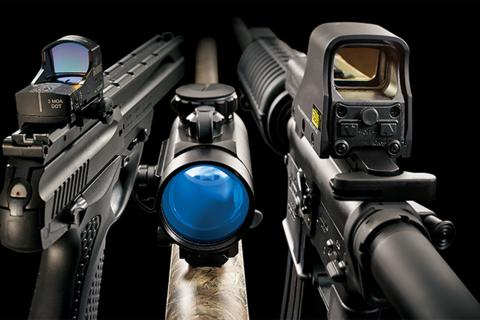
With recent advancements in technology, decking out firearms with the latest and coolest gadgets is quickly becoming a favorite pastime for gun owners. For turkey hunters, plinkers or tactical shooters, electronic sights are a fun way to make your firearm look great, while adding exceptional low-light functionality. Their design reduces parallax error and has unlimited eye relief, allowing you to use them with both eyes open, thus maintaining peripheral awareness. If you plan on topping your firearm with an electronic sight, it's important to understand what sets each of them apart so you know which one will work best for your application. While a sight can take an ordinary firearm and turn it into a great-looking piece of hardware, the No. 1 concern is still functionality. With an electronic sight, you can easily match scenarios. Once you figure out what you’ll be using your firearm for, add the electronic sight that provides the greatest benefit. Have fun, and always be safe.
RED-DOT SCOPES
We've all missed shot opportunities at lovestruck gobblers because crosshairs are so hard to see in dark river bottoms. Red-dot scopes remedy this problem. They use a reflected LED to generate a brightly colored aiming point, allowing us to zero in on strutting toms in super-low-light conditions. Because they use an LED, they have the best battery life of all electronic sights. This might seem like a small feature, but no one likes packing extra batteries. Another handy element is that they come in a huge variety of MOA dot sizes. 5-MOA dots and larger are great for close-range action where fast target acquisition is important. But since a large dot hinders accuracy by covering more of the target area, we need other options. 4-MOA dots and smaller create a fine aiming point that excels in situations like turkey hunting, where precision is the primary goal. Their price range makes them the most cost-effective route to getting an electronic sight mounted on your firearm.
HOLOGRAPHIC SIGHTS
Equipment failure has most likely affected everyone at some point. If it hasn't hit you yet, consider yourself among the lucky few. Holographic sights, even if their lens is broken or clouded with debris, are still going to project the reticle. In addition to their durability, they also have the fastest target acquisition among electronic sights. Using the same hologram-transmission technology used on fighter jets, they trick your eyes into perceiving the reticle image as being closer to your target than it actually is. This, along with a large-MOA circle encompassing a 1-MOA dot (the smallest available in any optic) gets you on target quickly with precision. Plus, when used with a 3X magnifier, the dot doesn't get larger, so you maintain accuracy on distant targets. Their cost is reflective of the technology involved and their advanced features.
PRISM SIGHTS
When waiting on a wary coyote to come into view during fading daylight, a prism sight gives you added confidence that whether it pops up 25 yds. or 300 yds. away, you'll be able to see well enough to put your crosshairs where they need to be. Prism sights are able to use more complex reticle shapes such as BDC reticles for extending your range beyond the typical electronic sight, and since they use prisms to shorten the light path the same way binoculars do, you get a lightweight, compact sight with magnification. Additionally, their glass-etched reticles usually come in multiple colors (red, green and black), so if your battery dies while afield, the black etched reticle still gives you a usable point of aim. Prism sights also come equipped with a Picatinny rail so you can add accessories to broaden their situational use. Their price is a compromise between red-dot and holographic sights.
PARALLAX
Parallax occurs when the target image and the reticle aren't on the same plane, causing the reticle to move in relation to the target if the eye isn't centered in the optic. Electric sights greatly reduce parallax, especially in holographic sights – meaning even if your eye is slightly off center, you'll still be on target.
• Your eye, reticle and target are lined up on the same optical plane.
• Your eye is extremely off center to the left; however, the reticle still aligns with the target.
• Now your eye is extremely off center to the right, and the reticle still aligns with the target. Thus, this sight is virtually parallax free.
MINUTE OF ANGLE
Minute of angle (MOA) is an arc measurement, and it's known that 1 MOA spreads out approximately 1" every 100 yds. So, with a traditional riflescope, once a bullet's impact point in relation to the reticle is known at a given distance, we can use MOA to bring the reticle and the desired impact point into alignment.
Electronic sights use MOA to calculate dot size. Knowing the rate at which MOA spreads every 100 yds., a buyer has a quick reference as to how large a dot appears. A 2-MOA dot covers approximately 2" of your target at 100 yds., a 4-MOA dot 4" at 100 yds. and so on.

- 2295 views

